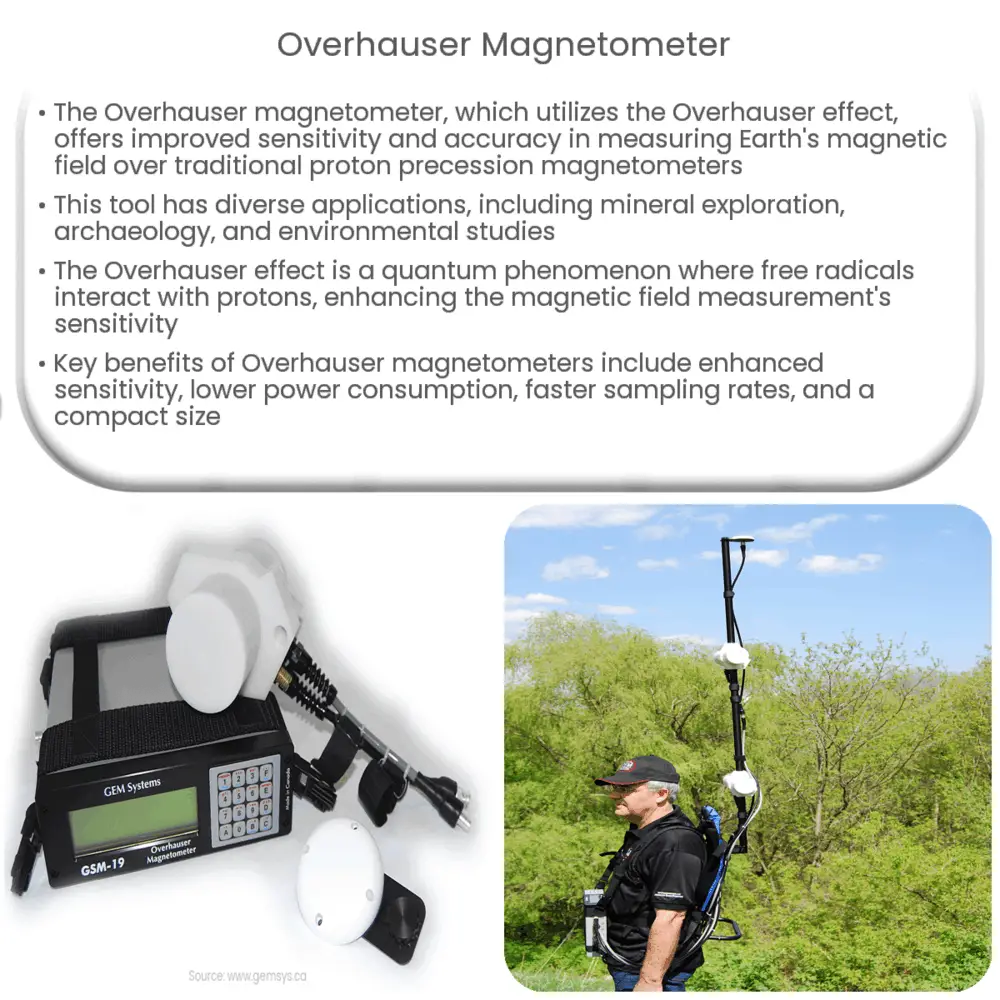Discover the Overhauser magnetometer, an advanced tool for Earth’s magnetic field measurements, with applications in geophysics, mineral exploration, archaeology, and environmental studies.

Overhauser Magnetometer: A Comprehensive Introduction
What is an Overhauser Magnetometer?
An Overhauser magnetometer is a type of proton precession magnetometer that utilizes the Overhauser effect to measure the Earth’s magnetic field. This advanced technology significantly enhances the sensitivity and accuracy of magnetic field measurements compared to conventional proton precession magnetometers. Overhauser magnetometers are widely used in a variety of fields, including mineral exploration, archaeology, environmental studies, and geophysics.
Understanding the Overhauser Effect
The Overhauser effect, named after American physicist Albert Overhauser, is a quantum mechanical phenomenon that occurs when unpaired electrons in a free radical interact with nearby protons in a polar molecule, such as water. This interaction causes a transfer of polarization from the electrons to the protons, enhancing the proton’s magnetic moment and, consequently, the sensitivity of the magnetic field measurement.
In an Overhauser magnetometer, this phenomenon is induced by exposing a sample of water containing a free radical to a radiofrequency (RF) magnetic field. The RF field causes the free electrons to resonate, transferring their polarization to the protons in the water. This process significantly increases the signal-to-noise ratio, enabling more accurate measurements of the Earth’s magnetic field.
Advantages of Overhauser Magnetometers
Overhauser magnetometers offer several key advantages over conventional proton precession magnetometers:
- Enhanced Sensitivity: The Overhauser effect results in a stronger and more easily detectable signal, which translates to a higher sensitivity and more accurate magnetic field measurements.
- Lower Power Consumption: The RF excitation used in Overhauser magnetometers requires significantly less power than the pulsed magnetic fields used in conventional proton precession magnetometers, leading to extended battery life and reduced energy costs.
- Faster Sampling Rates: Due to their increased sensitivity, Overhauser magnetometers can obtain accurate measurements at faster sampling rates, allowing for more efficient data collection in the field.
- Reduced Sensor Size: The use of RF excitation allows for a smaller sensor coil, resulting in a more compact and portable instrument.
Applications of Overhauser Magnetometers
Overhauser magnetometers are used in a wide range of applications, including:
- Mineral Exploration: Accurate magnetic field measurements can help identify mineral deposits and geological structures, aiding in the search for valuable resources such as gold, iron, and copper.
- Archaeology: By mapping variations in the Earth’s magnetic field, Overhauser magnetometers can reveal buried structures and artifacts, providing valuable information about past civilizations.
- Environmental Studies: Monitoring magnetic field variations can help detect changes in geological formations and groundwater levels, providing essential data for environmental impact assessments and land use planning.
- Geophysics: Overhauser magnetometers are instrumental in studying the Earth’s magnetic field, contributing to our understanding of the planet’s geodynamics and geomagnetic phenomena.
Choosing an Overhauser Magnetometer
When selecting an Overhauser magnetometer for a specific application, several factors should be considered:
- Resolution and Sensitivity: Higher-resolution magnetometers provide more accurate magnetic field measurements, which can be crucial for applications such as mineral exploration and geophysics.
- Sampling Rate: Depending on the application, a faster sampling rate might be necessary to cover larger areas in a shorter period or to capture transient magnetic field variations.
- Portability: For field applications, a compact and lightweight magnetometer is advantageous, as it is easier to transport and deploy.
- Power Consumption: Lower power consumption is important for extended field operations, as it reduces the need for frequent battery replacements or recharging.
- Data Processing and Visualization: Advanced software capabilities for processing and visualizing collected data can streamline the interpretation and analysis process.
Operating an Overhauser Magnetometer
While Overhauser magnetometers are advanced scientific instruments, they are designed to be user-friendly and straightforward to operate. The following are general steps for using an Overhauser magnetometer:
- Setup: Deploy the magnetometer sensor and ensure it is securely positioned on the ground or another stable surface. Connect the sensor to the data acquisition unit.
- Initialization: Power on the data acquisition unit and initialize the instrument. This may involve calibrating the magnetometer or inputting specific measurement parameters, such as sampling rate or duration.
- Data Collection: Start the measurement process and allow the magnetometer to collect data for the specified duration or until the desired number of samples has been acquired.
- Data Retrieval: Transfer the collected data from the data acquisition unit to a computer or another storage device for further analysis and processing.
- Data Analysis: Use specialized software to process and visualize the magnetic field data, enabling interpretation and identification of relevant patterns or anomalies.
Conclusion
The Overhauser magnetometer is an advanced and versatile instrument for measuring the Earth’s magnetic field. Its enhanced sensitivity, lower power consumption, and faster sampling rates make it an invaluable tool for various applications, including mineral exploration, archaeology, environmental studies, and geophysics. By understanding the Overhauser effect and the key factors to consider when selecting an Overhauser magnetometer, professionals and researchers can harness the full potential of this cutting-edge technology to advance their field of study and uncover new insights about the Earth.

